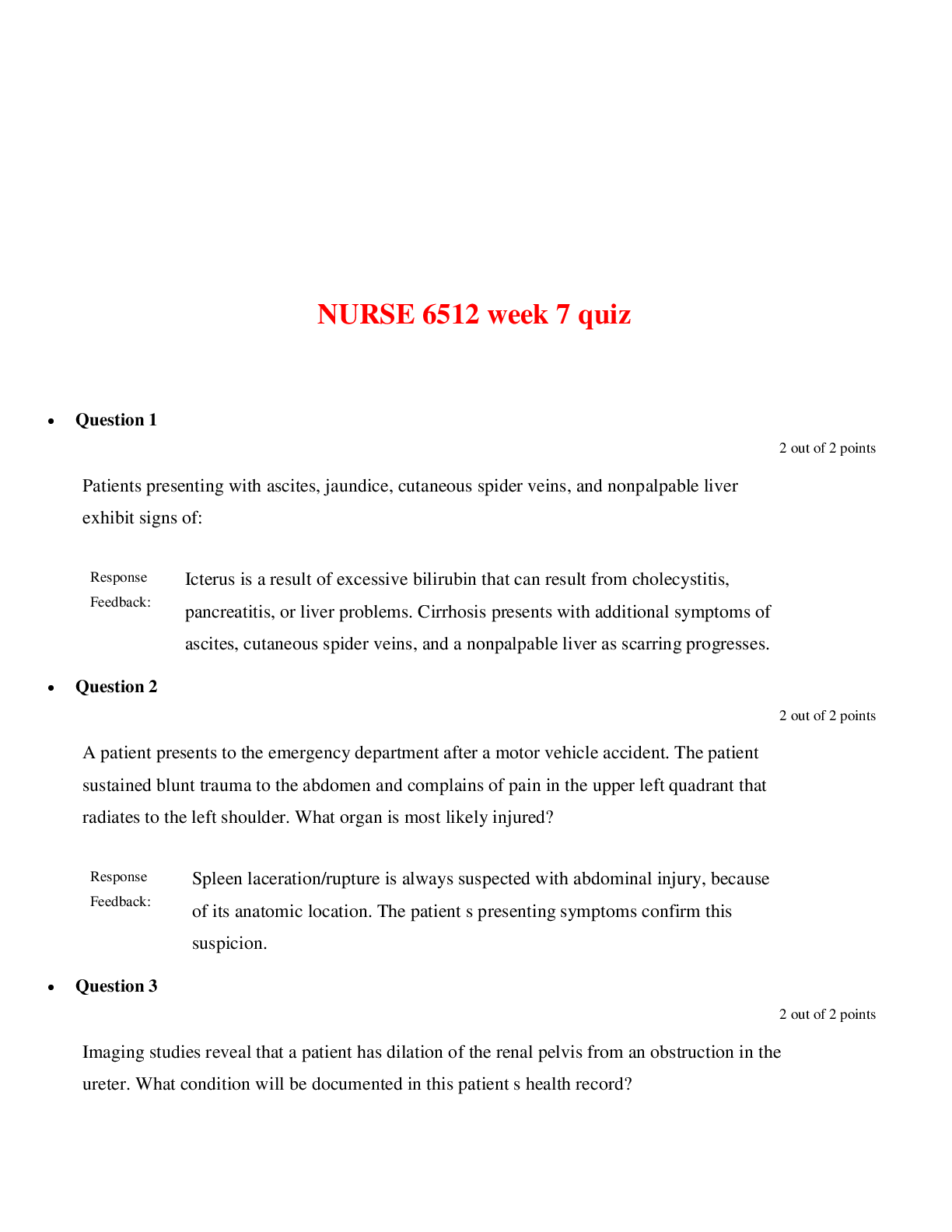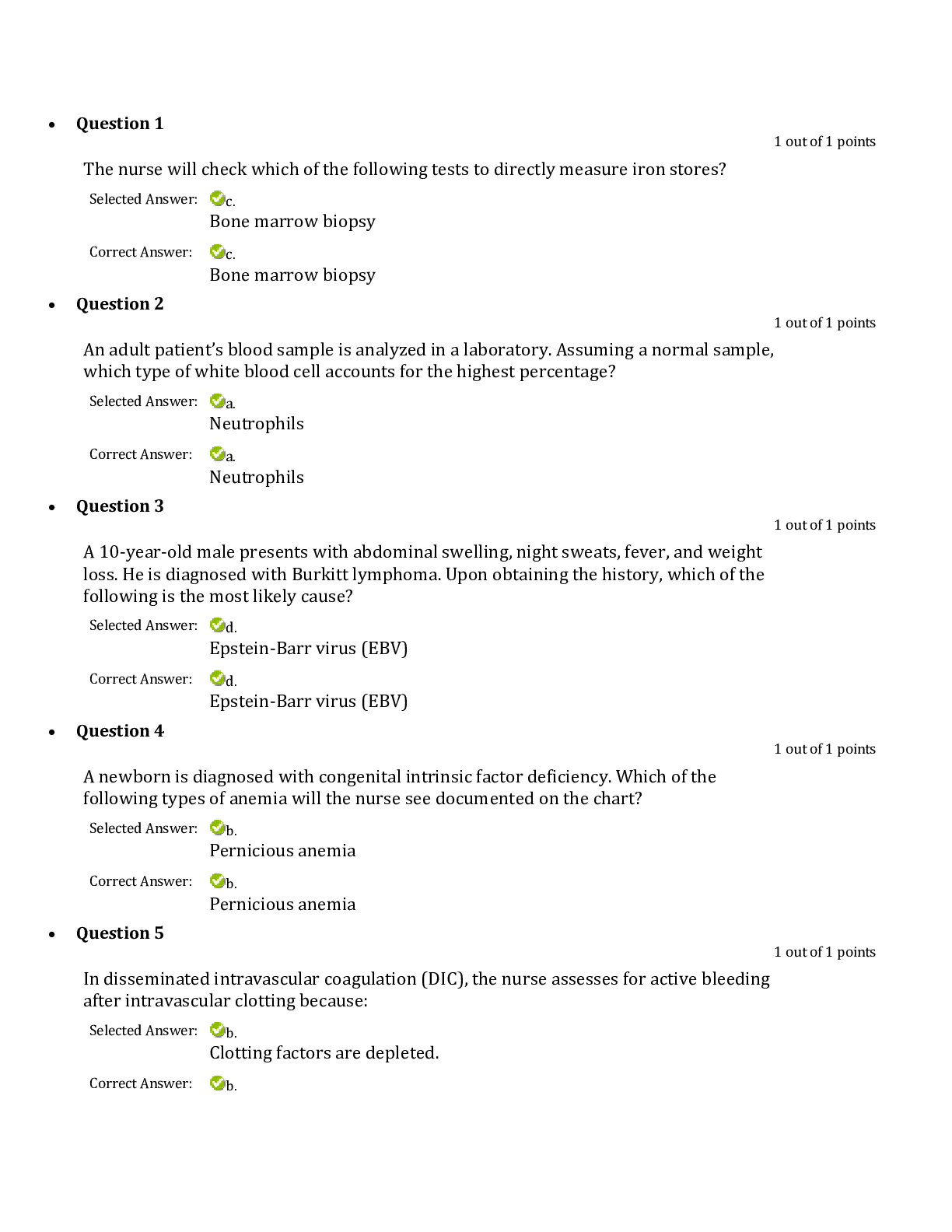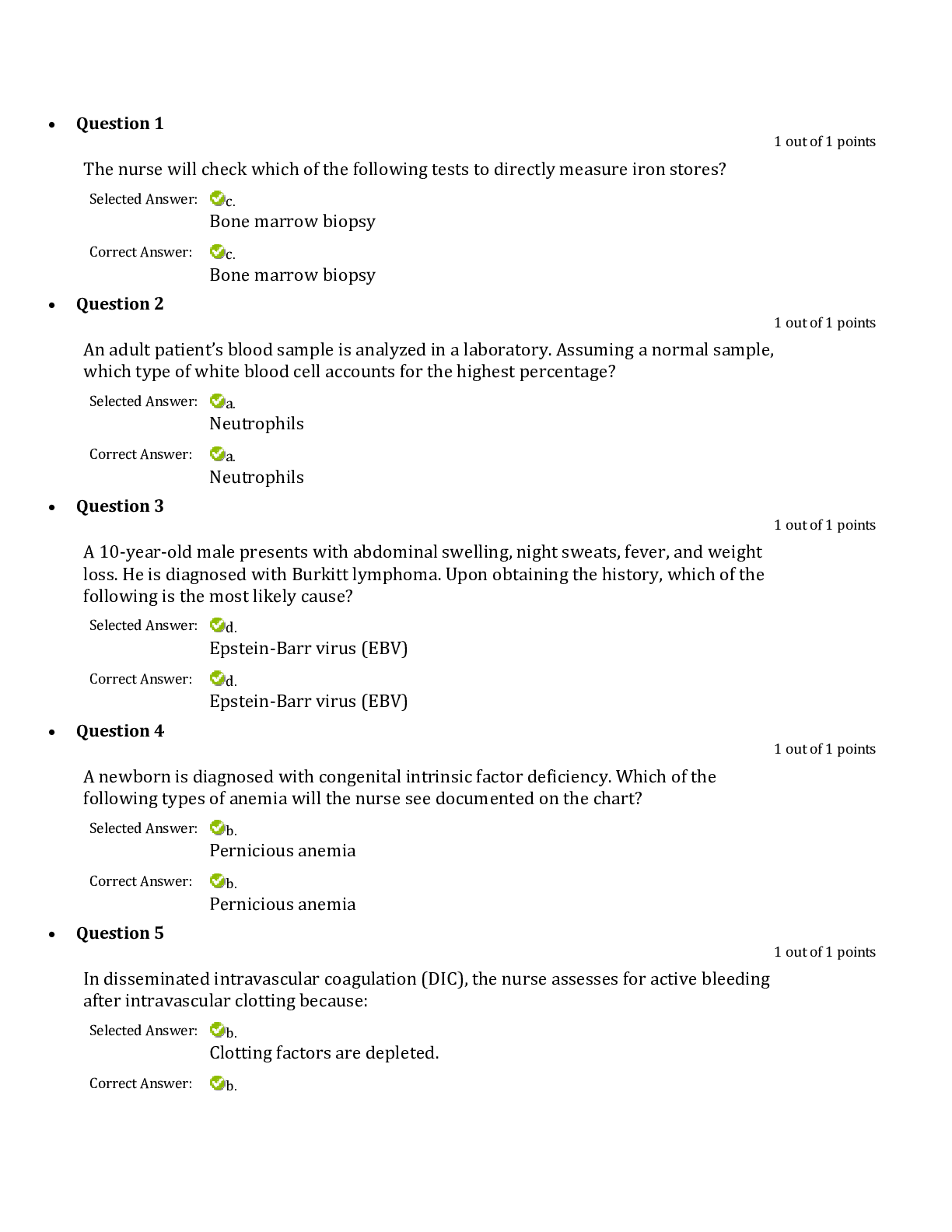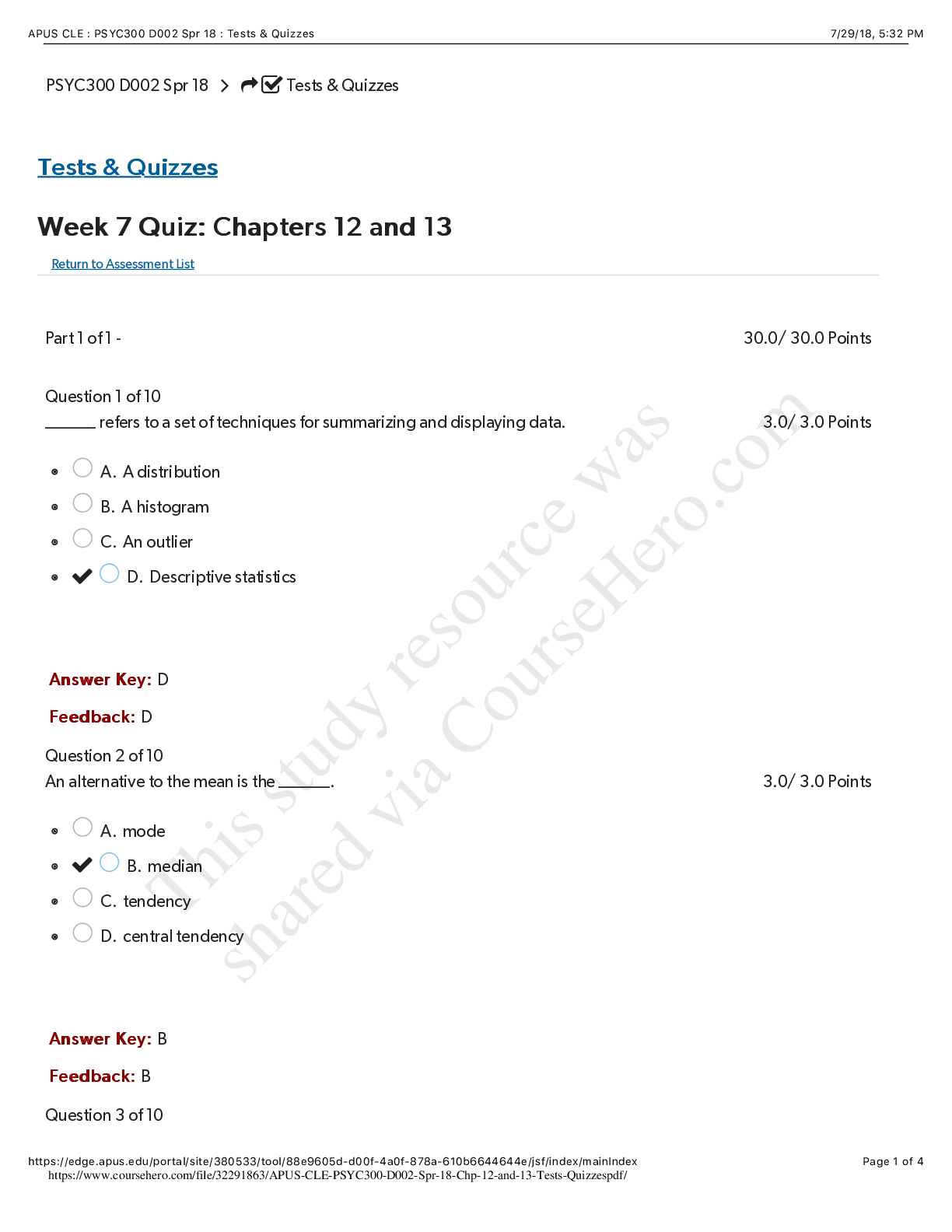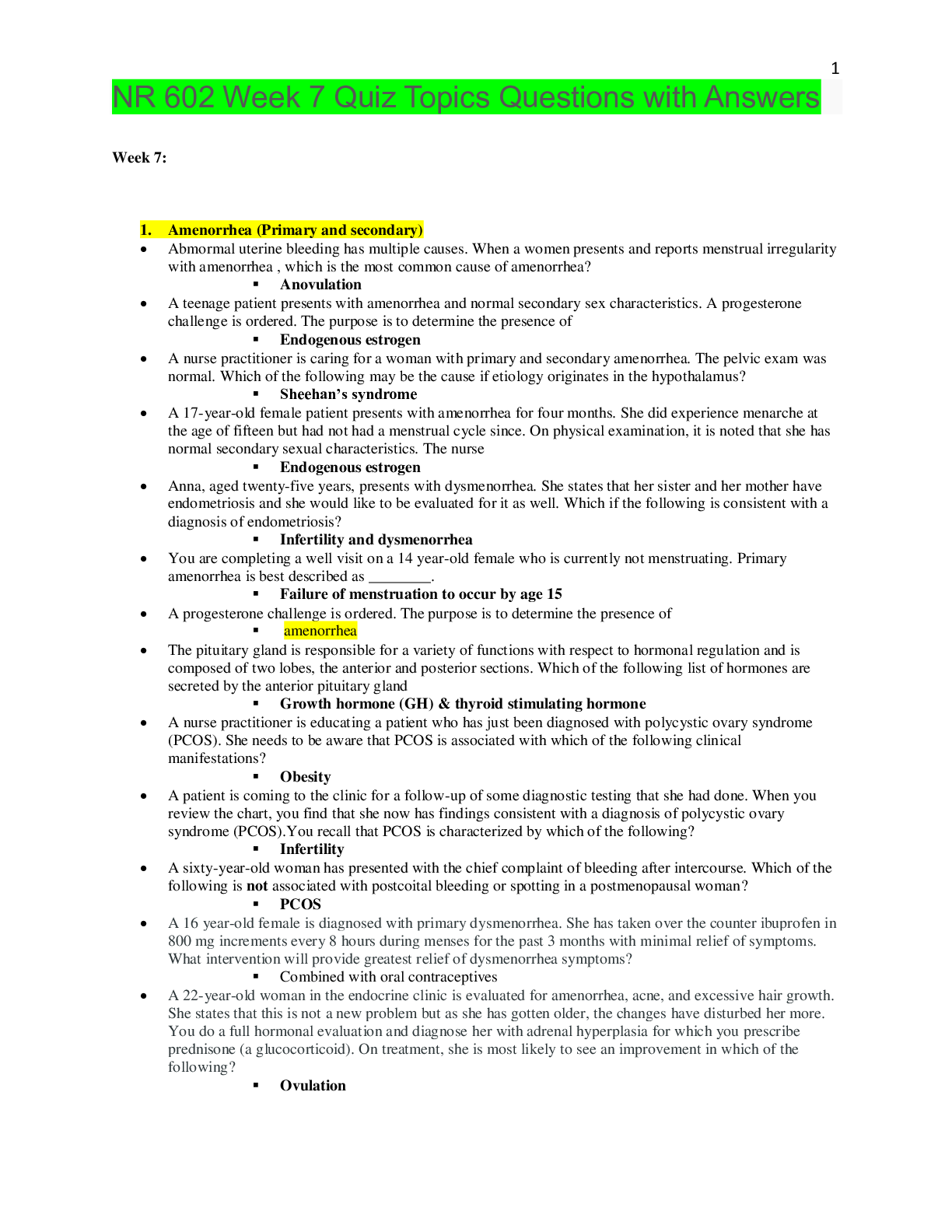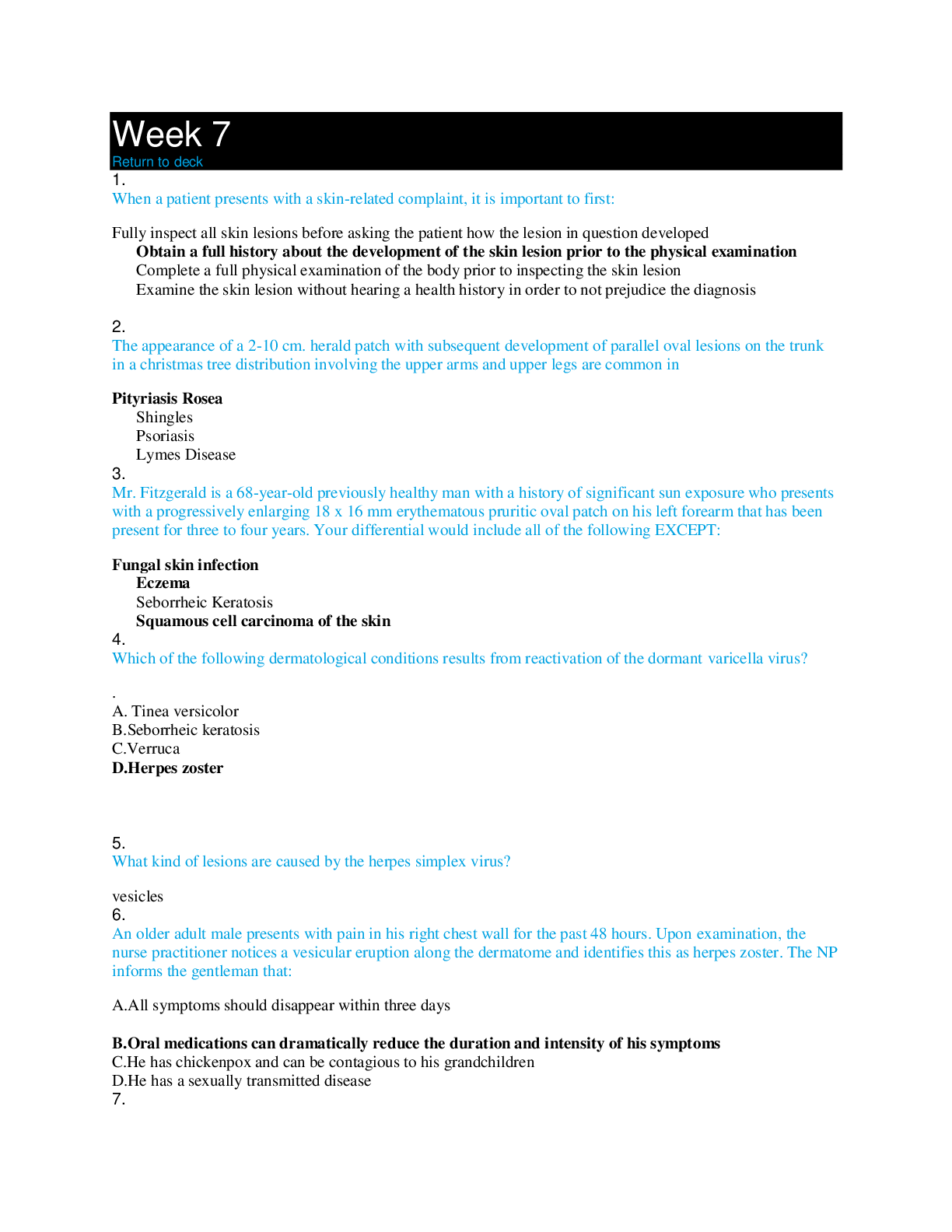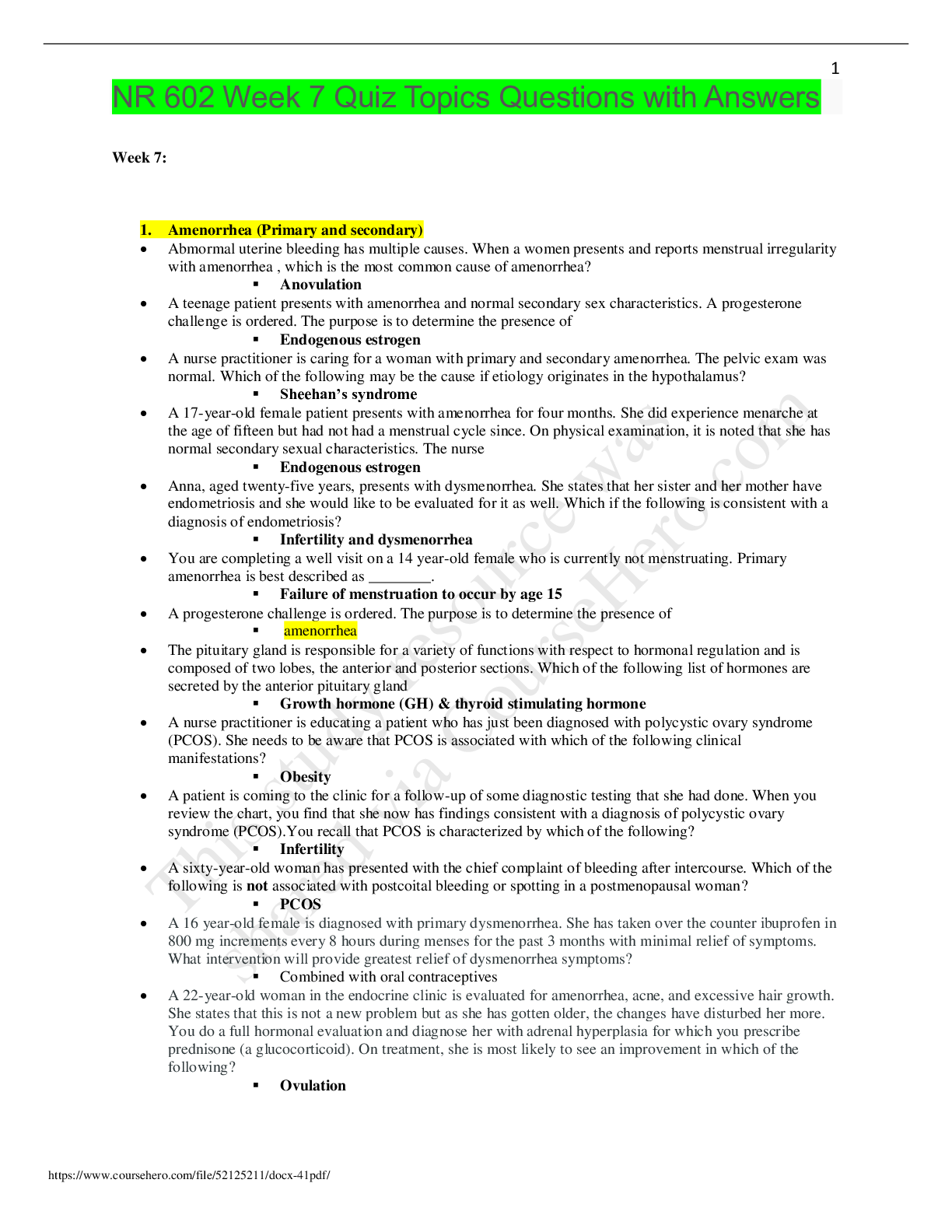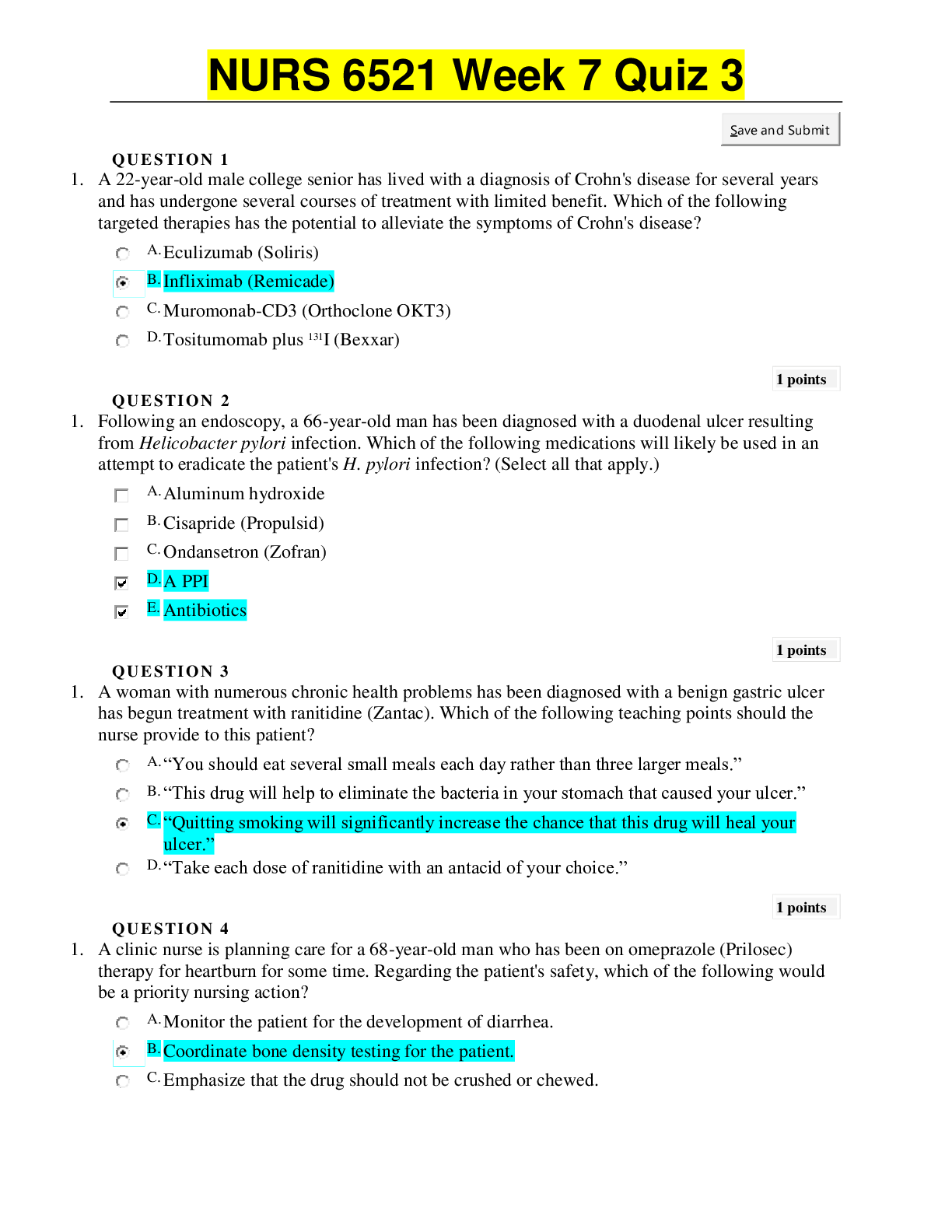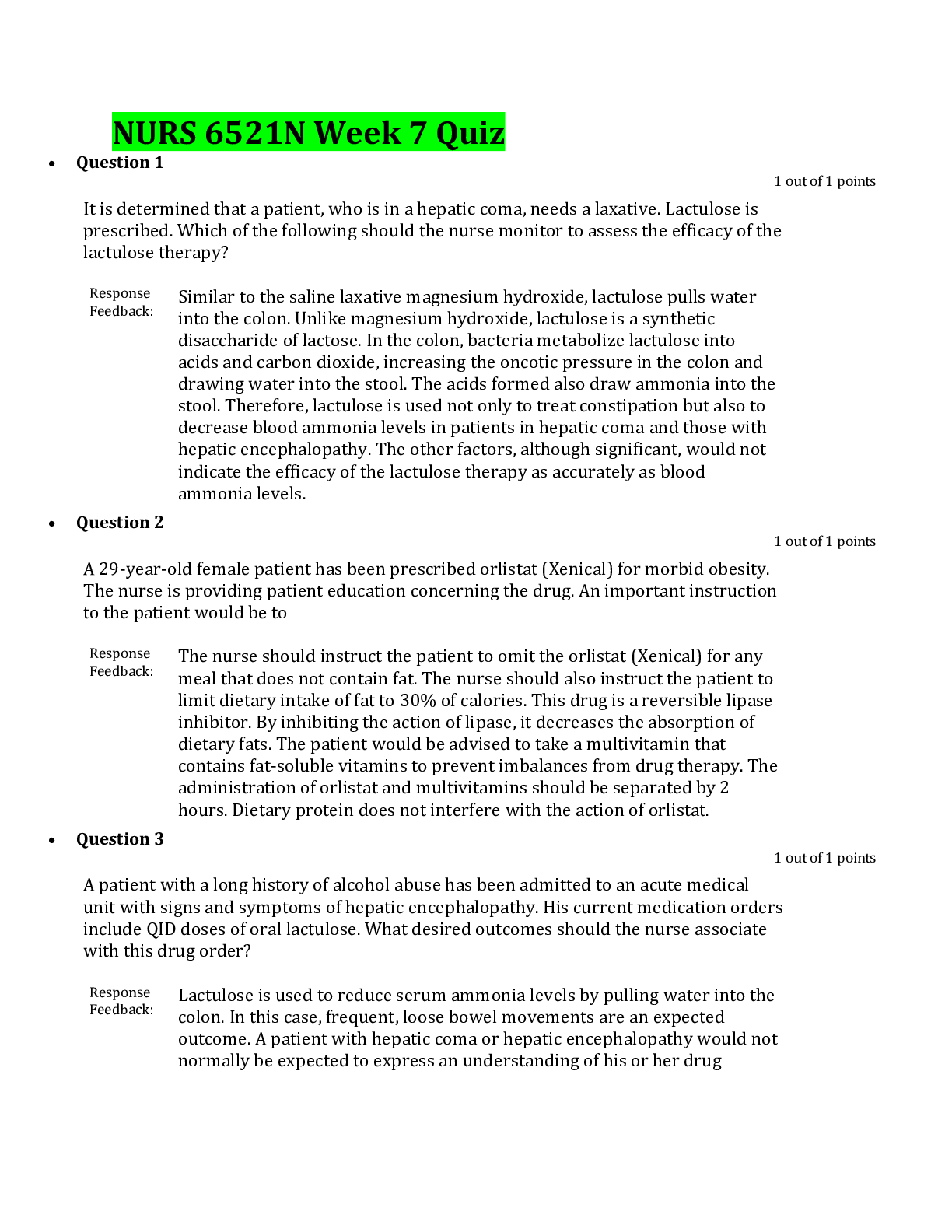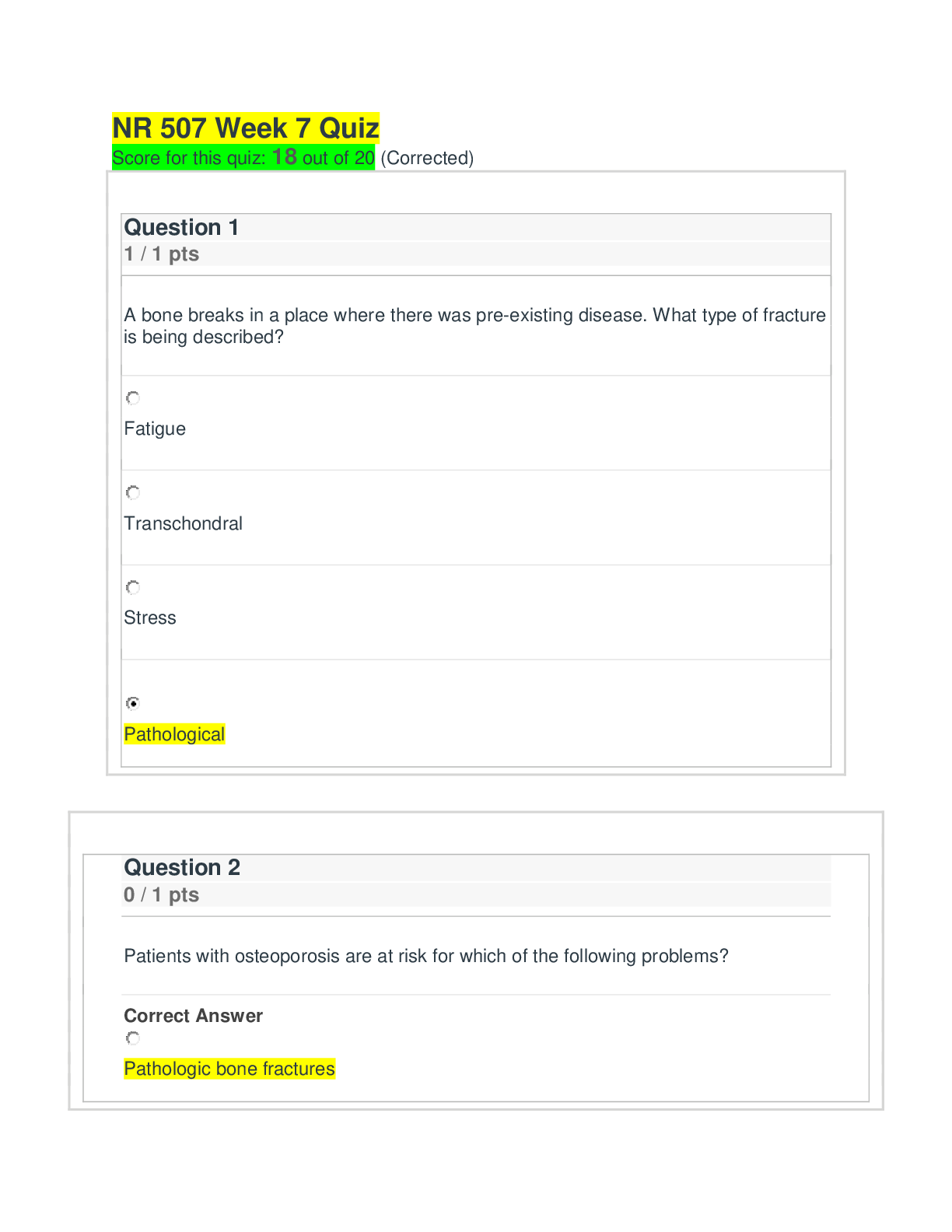Mathematics > EXAM > MATH 221 Week 7 Quiz (fixes) Corrections to versions of Questions 1, 2, 3, 6, 23, 24, 26, 27, 28, 30 (All)
MATH 221 Week 7 Quiz (fixes) Corrections to versions of Questions 1, 2, 3, 6, 23, 24, 26, 27, 28, 30 | Download To Score An A.
Document Content and Description Below
MATH221 Week 7 Quiz Corrections to versions of Questions 1, 2, 3, 6, 23, 24, 26, 27, 28, 30 Question 1 version 3 (CO6) From a random sample of 68 businesses, it is found that the mean time that e... mployees spend on personal issues each week is 45.8 5.8 hours with a standard deviation of 0.35 hours. What is the 95% confidence interval for the amount of time spent on personal issues? @See text page 301 a. (5.74, 5.90) b. (5.71, 5.89) c. (5.73, 5.87) *d. (5.72, 5.88) Question 2 version 1 (CO6) If a confidence interval is given from 8.52 to 10.23 and the mean is known to be 9.375, what is the maximum error margin of error? a. 0.428 b. 1.710 c. 8.520 *d. 0.855 Question 2 version 2 If a confidence interval is given from 8.50 to 10.25 and the mean is known to be 9.375, what is the maximum error margin of error? @See text page 301 *a. 0.875 b. 0.438 c. 1.750 d. 8.500 Question 2 version 3 (CO6) If a confidence interval is given from 8.54 to 10.21 and the mean is known to be 9.375, what is the maximum error margin of error? @See text page 301 a. 0.418 *b. 0.835 c. 8.540 d. 1.670 Question 2 version 4 8. (CO6) If a confidence interval is given from 8.56 to 10.19 and the mean is known to be 9.375, what is the maximum error margin of error? @See text page 301 a. 1.630 b. 8.560 *c. 0.815 d. 0.408 Question 3 version 1 9. (CO6) Which of the following is most likely to lead to a small maximum error margin of error? @See text page 301 *a. large sample size b. small mean c. small standard deviation d. large maximum error margin of error Question 3 version 2 10. (CO6) Which of the following is most likely to lead to a large maximum error margin of error? @See text page 301 a. large sample size b. small mean c. small standard deviation *d. small sample size Question 6 version 3 23. (CO6) What is the 97% confidence interval for a sample of 104 soda cans that have a mean amount of 12.10 ounces and a standard deviation of 0.08 ounces? @See text page 301 a. (12.035, 12.065) b. (12.020, 12.180) c. (12.033, 12.067) *d. (12.083, 12.1217 12.117) Question 23 version 3 (CO7) A light bulb manufacturer guarantees that the mean life of a certain type of light bulb is at least 720 hours. A random sample of 51 light bulbs as a mean of 705.4 hours with a standard deviation of 62 hours. At α = 0.05, can you support the company’s claim using the test statistic? @See text pages 368-370 a. Claim is the alternative, fail to reject the null and cannot support claim as the test statistic (-1.68) is in the rejection region defined by the critical value (-1.96) *b. Claim is the null, reject the null and cannot support claim as test statistic (-1.68) is in the rejection region defined by the critical value (-1.645) c. Claim is the alternative, reject the null and support claim as test statistic (-1.68) is not in the rejection region defined by the critical value (-1.96) d. Claim is the null, fail to reject the null and cannot support claim as test statistic (-1.68) is not in the rejection region defined by the critical value (-1.645) Question 23 version 4 (CO7) A light bulb manufacturer guarantees that the mean life of a certain type of light bulb is at least 720 hours. A random sample of 51 light bulbs as a mean of 701.6 hours with a standard deviation of 62 hours. At α = 0.05, can you support the company’s claim using the test statistic? @See text pages 368-370 a. Claim is the null, reject the null and can support claim as test statistic (-2.12) is not in the rejection region defined by the critical value (-1.645) b. Claim is the alternative, fail to reject the null and cannot support claim as the test statistic (-2.12) is in the rejection region defined by the the critical value (-1.96) *c. Claim is the null, reject the null and cannot support claim as test statistic (-2.12) is in the rejection region defined by the critical value (-1.645) d. Claim is the alternative, reject the null and support claim as test statistic (-2.12) is not in the rejection region defined by the critical value (-1.96) Question 24 version 1 (CO7) A restaurant claims the customers receive their food in less than 16 minutes. A random sample of 39 customers finds a mean wait time for food to be 15.8 minutes with a standard deviation of 4.9 minutes. At α = 0.04, what type of test is this and can you support the organizations’ claim using the test statistic? @See text pages 368-370 a. Claim is the null, fail to reject the null so support the claim as test statistic (-0.25) is not in the rejection region defined by the critical value (-1.75) *b. Claim is the alternative, fail to reject the null so cannot support the claim as test statistic (-0.25) is not in the rejection region defined by the critical value (-1.75) c. Claim is the null, reject the null so cannot support the claim as test statistic (-0.25) is in the rejection region defined by the critical value (-2.05) d. Claim is the alternative, reject the null so support the claim as test statistic (-0.25) is in the rejection region defined by the critical value (-2.05) Question 24 version 2 (CO7) A restaurant claims the customers receive their food in less than 16 minutes. A random sample of 39 customers finds a mean wait time for food to be 15.8 minutes with a standard deviation of 4.1 minutes. At α = 0.04, what type of test is this and can you support the organizations’ claim using the test statistic? @See text pages 368-370 a. Claim is the null, fail to reject the null so cannot support the claim as test statistic (-0.30) is not in the rejection region defined by the critical value (-1.75) *b. Claim is the alternative, fail to reject the null so fail to support the claim as test statistic (-0.30) is not in the rejection region defined by the critical value (1.75) c. Claim is the null, reject the null so cannot support the claim as test statistic (-0.30) is in the rejection region defined by the critical value (1.75) d. Claim is the alternative, reject the null so support the claim as test statistic (-0.30) is in the rejection region defined by the critical value (-2.05) Question 26 version 1 A travel analyst claims that the mean room rates at a three-star hotel in Chicago is greater than $152. In a random sample of 36 three-star hotel rooms in Chicago, the mean room rate is $163 with a standard deviation of $41. At α = 0.10, what type of test is this and can you support the analyst’s claim using the p-value? @See text pages 365-366 *a. Claim is the alternative, reject the null as p-value (0.054) is less than alpha (0.10), and can support the claim b. Claim is the null, fail to reject the null as p-value (0.054) is less than alpha (0.10), and cannot support the claim c. Claim is the null, reject the null as p-value (0.054) is less than alpha (0.10), and cannot support the claim d. Claim is the alternative, fail to reject the null as p-value (0.054) is less than alpha (0.10), and can support the claim Question 27 version 1 105. (CO7) A car company claims that the mean gas mileage for its luxury sedan is at least 24 miles per gallon. A random sample of 7 cars has a mean gas mileage of 23 miles per gallon and a standard deviation of 3.5 miles per gallon. At α = 0.05, can you support the company’s claim? @See text pages 379-380 a. No, since the test statistic is in the rejection region defined by the critical value, the null is rejected. The claim is the null, so is not supported b. Yes, since the test statistic is not in the rejection region defined by the critical value, the null is not rejected. The claim is the null, so is supported c. No, since the test statistic is not in the rejection region defined by the critical value, the null is not rejected. The claim is the null, so is supported *d. Yes, since the test statistic is not in the rejection region defined by the critical value, the null is not rejected. The claim is the null, so is supported Question 27 version 3 (CO7) A car company claims that the mean gas mileage for its luxury sedan is at least 24 miles per gallon. A random sample of 7 cars has a mean gas mileage of 23 miles per gallon and a standard deviation of 2.4 miles per gallon. At α = 0.05, can you support the company’s claim? @See text pages 379-380 a. No, since the test statistic is in the rejection region defined by the critical value, the null is rejected. The claim is the null, so is not supported b. Yes, since the test statistic is not in the rejection region defined by the critical value, the null is not rejected. The claim is the null, so is supported c. No, since the test statistic is not in the rejection region defined by the critical value, the null is not rejected. The claim is the null, so is supported *d. Yes, since the test statistic is not in the rejection region defined by the critical value, the null is not rejected. The claim is the null, so is supported Question 27 version 4 (CO7) A car company claims that the mean gas mileage for its luxury sedan is at least 24 miles per gallon. A random sample of 7 cars has a mean gas mileage of 23 miles per gallon and a standard deviation of 31.2 1.2 miles per gallon. At α = 0.05, can you support the company’s claim? @See text pages 379-380 a. No, since the test statistic is in the rejection region defined by the critical value, the null is rejected. The claim is the null, so is not supported *b. Yes, since the test statistic is not in the rejection region defined by the critical value, the null is not rejected. The claim is the null, so is supported c. No, since the test statistic is not in the rejection region defined by the critical value, the null is not rejected. The claim is the null, so is supported d. Yes, since the test statistic is not in the rejection region defined by the critical value, the null is not rejected. The claim is the null, so is supported Question 28 version 1 (CO7) A state Department of Transportation claims that the mean wait time for various services at its different location is less more than 6 minutes. A random sample of 16 services at different locations has a mean wait time of 9.5 minutes and a standard deviation of 7.3 minutes. At α = 0.01, can the department’s claim be supported? @See text page 382 a. No, since p of 0.037 is greater than 0.01, reject the null. Claim is null, so is not supported *b. No, since p of 0.037 is greater than 0.01, fail to reject the null. Claim is alternative, so is not supported c. Yes, since p of 0.037 is less than 0.07, reject the null. Claim is alternative, so is supported d. Yes, since p of 0.037 is greater than 0.01, fail to reject the null. Claim is null, so is supported Question 28 version 2 (CO7) A state Department of Transportation claims that the mean wait time for various services at its different location is less more than 6 minutes. A random sample of 16 services at different locations has a mean wait time of 9.5 minutes and a standard deviation of 7.6 minutes. At α = 0.01, can the department’s claim be supported? @See text page 382 a. Yes, since p of 0.043 is less than 0.09, reject the null. Claim is alternative, so is supported b. No, since p of 0.043 is greater than 0.01, reject the null. Claim is null, so is not supported *c. No, since p of 0.043 is greater than 0.01, fail to reject the null. Claim is alternative, so is not supported d. Yes, since p of 0.043 is greater than 0.01, fail to reject the null. Claim is null, so is supported Question 28 version 3 (CO7) A state Department of Transportation claims that the mean wait time for various services at its different location is less more than 6 minutes. A random sample of 16 services at different locations has a mean wait time of 9.5 minutes and a standard deviation of 7.3 minutes. At ?=0.05, can the department’s claim be supported? @See text page 382 a. No, since p of 0.037 is less than 0.05, reject the null. Claim is null, so is not supported b. No, since p of 0.037 is less than 0.05, fail to reject the null. Claim is alternative, so is not supported *c. Yes, since p of 0.037 is less than 0.07 0.05, reject the null. Claim is alternative, so is supported d. Yes, since p of 0.037 is less than 0.05, fail to reject the null. Claim is null, so is supported Question 28 version 4 112. (CO7) A state Department of Transportation claims that the mean wait time for various services at its different location is less more than 6 minutes. A random sample of 16 services at different locations has a mean wait time of 9.5 minutes and a standard deviation of 7.6 minutes. At ?=0.05, can the department’s claim be supported? @See text page 382 a. Yes, since p of 0.043 is greater than 0.05, fail to reject the null. Claim is null, so is supported b. No, since p of 0.043 is greater than 0.05, reject the null. Claim is null, so is not supported [change so option is correct one]c. Yes, since p of 0.043 is less than 0.07 0.05, reject the null. Claim is alternative, so is supported d. No, since p of 0.043 is greater than 0.05, fail to reject the null. Claim is alternative, so is not supported Question 30 version 2 (CO7) A researcher wants to determine if eating more vegetables helps high school juniors learn algebra. One junior class has extra vegetables and another junior class does not. After 2 weeks, the entire both classes take an algebra test and the results of the two groups are compared. To be a valid matched pair test, what should the researcher consider in creating the two groups? @See text page 418 a. That the group without extra vegetables receives different instruction [make correct choice]b. That each pair of students has similar IQs or abilities in mathematics c. That each class of students has similar ages at the time of the testing d. That each class has similar average IQs or abilities in mathematics Question 30 version 4 (CO7) A researcher wants to determine if lead levels are different between the top of a glass of water and the bottom of a glass of water. Many samples of water are taken. From half, the lead level at the top is measured and from half, the lead level at the bottom is measured. Would this be a valid matched pair test? @See text page 418 a. Yes, as long as there are an equal number of glasses in each group *b. No, as the measurements of top and bottom should be from the same glass c. Yes, as long as they are all from the same faucet d. No, as the zinc lead levels cannot be accurately measured [Show More]
Last updated: 1 year ago
Preview 1 out of 6 pages
Instant download
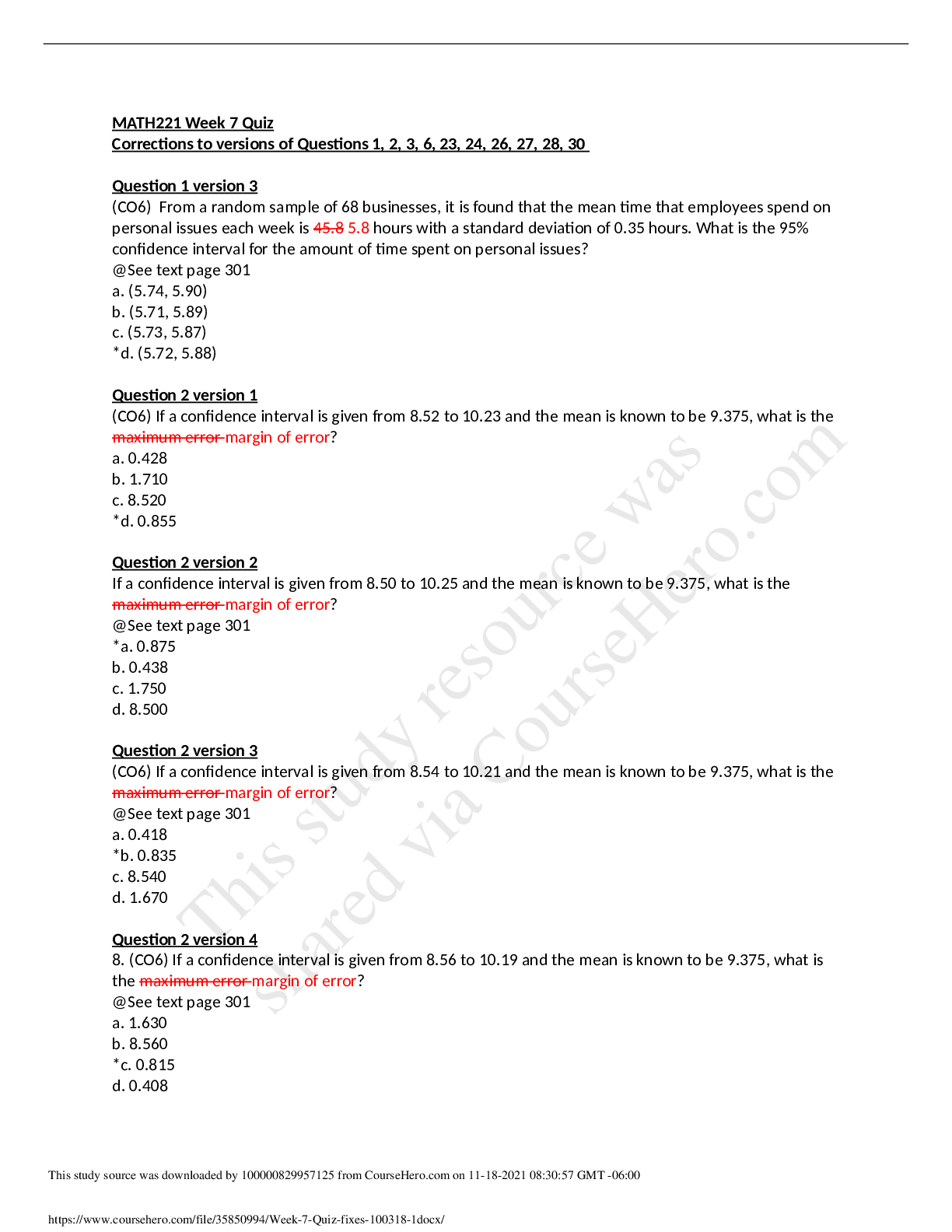
Buy this document to get the full access instantly
Instant Download Access after purchase
Add to cartInstant download
Reviews( 0 )
Document information
Connected school, study & course
About the document
Uploaded On
Nov 18, 2021
Number of pages
6
Written in
Additional information
This document has been written for:
Uploaded
Nov 18, 2021
Downloads
0
Views
84






.png)






